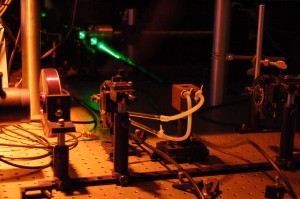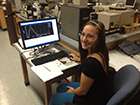 |
|
Contact Information
Office: MEYR 549A
Phone: 410-455-2507
Email: lkelly@umbc.edu
|
Professor
Research Interests
Photochemical probes of macromolecular structure.
Advances in genomics and proteomics require new tools in molecular biology. In our laboratory, we are developing synthetic organic and inorganic molecules as structural probes of DNA and proteins. Through molecular engineering, we synthesize the compounds to recognize and bind to specific DNA sequences or protein residues. To date, we have used naphthalimide derivatives that are readily synthesized and functionalized. Upon activation with UV or visible light, the compounds initiate a sequence of chemical events that lead to cleavage of the macromolecule at the binding site. In parallel, transient laser spectroscopy is used to understand reaction mechanisms. Once the fragments are identified using HPLC and mass spectrometry, the DNA or protein structure may be reconstructed. Thus, these ‘photonucleases’ and ‘photoproteases’ provide new tools to identify the sequence and 3D structure of DNA and proteins.
Stimuli-Responsive Polymers.
Stimuli-responsive polymers find broad-ranging applications in smart materials and smart packaging applications. Our group is interested in building functionalized polymers that respond, via basic photophysical phenomena, to changes in external stimuli (temperature, pressure, etc.). Fundamentally, we are interested in gaining knowledge about how the polymer architecture governs, among other things, the thermal properties of the polymer. Traditional synthetic polymer chemistry is used to systematically build and functionalize the polymers. NMR, mass spectrometry, and DSC are used to characterize the materials. Steady-state and time-resolved fluorescence methods are used to understand the fundamental photophysics. Specifically, using time-correlated single-photon counting, the polymer dynamics and rate constants for excited-state interconversions, are mapped out to understand which elementary reaction step controls the temperature-dependent photophysics. As a result, systematic structure-function correlations are obtained.
Selected Publications
Kelly, L. A., “4-Amino-1,8-Naphthalimides and Related Species.” In The Chemistry of Nitrogen-Rich Functional Groups, Volume 2; Greer, A. and Liebman, J. F., Eds.; PATAI’s Chemistry of Functional Groups, Accepted May 13, 2022.
Setera, B. Su; C,-H.; Arnold, B. R.; Choa, F,-S.; Kelly, L.; Sood, R.; Singh, N. B.; “Comparative Study of Bulk and Nanoengineered Doped ZnSe,” Crystals, 2022, 12, 71-79. https://doi.org/10.3390/cryst12010071
Singh, A.U.; Machuga, K. S.; Prasad, H.; Mandal, K.; Kelly, L.; Arnold, B.; Choa, F. –S.; Cullum, B.; Austin, G.; Singh, N. B.; “Dissolution of Kidney Stones; Nano and Micro Morphologies Developed During Remelting,” Curr. Res. Mat. Chem, 2022, 3, 113. https://doi.org/10.33790/crmc1100113
Emge, I.; Scheurer, L.; Grant, R.; Prasad, N.; Kelly, L.; Arnold, B.; Choa, F. -S.; Setera, B.; Singh, N. B.; “Surface Characteristics of Polymer Nanocomposites,” Proc. SPIE – Soc. Opt. Eng., 2021, 11757, 117570X1-117570X4. https://doi.org/10.1117/12.2585834
Emge, I.; Kazal, D.; Cooper, C.; Sood, R.; Saraf, S.; Su, C. H.; Cullum, B.; Choa, F.-S.; Arnold, B. R.; Kelly, L.; Singh, N. B.; “Optimization of Sensor Materials Using Physical Vapor Transport Growth Method,” Proc. SPIE – Soc. Opt. Eng., 2021, 11757, 117570O. https://doi.org/10.1117/12.2586081
Kelly, Lisa A.; Roll, Melissa; Joseph, Jayan; Seenisamy, Jeyaprakashnarayanan; Barrett, Justin; Kauser, Katalin; Warner, Kevin S.”Solvent-Dependent Photophysics and Reactivity of Monomeric and Dimeric 4-Amino-1,8-Naphthalimides,” J. Phys. Chem. A, 2021, 125, 2294-2307. doi.org/10.1021/acs.jpca.0c11639.
Sova, Stacey and Kelly, Lisa A.; “Formation and Reaction Kinetics of Biradicals and Triplet States in a Series of Carboxylated 1,4,5,8-Naphthalene Diimides,” J. Phys. Chem. A, 2020, 124, 7453 – 7463. doi.org/10.1021/acs.jpca.0c06639
Hopanna, Mamatha; Kelly, Lisa A.; Blaney, Lee “Photochemistry of the Organoselenium Compound Ebselen: Direct Photolysis and Reaction with Active Intermermediates of Conventional Reactive Species, Sensitizers and Quenchers,” Env. Sci. Tech, 2020, Just Accepted Manuscript, doi.org/10.1021/acs.est.0c03093.
Setera, Brett, Arnold, Bradley, Choa, Fow-Sen, Kelly, Lisa, Emge, Ian, Su, Charmain, Machuga, Krishna S., Singh, N.B. “Design and Measurements of n for the Multicomponent Semiconductor,” Proc. SPIE, 2020, 11498, 11498, 1149803-1 -1149803-7. doi.org/10.1117/12.2566997.
Emge, Ian; Su, Charmain; Sood, Rachit; Arnold, Bradley; Choa, Fow-Sen; Kelly, Lisa; Mandal, KD; Verma, Manish K; Singh, NB “Chemical and Biological Sensing Using Polarity of Material,” Proc. SPIE, 2020, 11416, 1141610-1 – 1141610-6. doi.org/10.1117/12.2563877
Singh, Narsingh B; Su, Ching-Hua; Choa, Fow-Sen; Arnold, Bradley; Cooper, Christopher; Cullum, Brian; Kelly, Lisa “Morphology and Performance of Organic Nanocomposites for γ-Ray Sensing,” Emerging Mater. Res., 2020, 9, 1 – 7. doi.org/10.1680/jemmr.18.00050
Sova, S. and Kelly, Lisa A. “Enzyme Modification and Oxidative Crosslinking using Carboxylate-, Phenol- and Catechol-Conjugated 1,8-Naphthalimides,” Photochemi. Photobiol., 2019, 95, 1169 – 1178. doi: 10.1111/php.13110
Sova, Stacey; Prasad, Narasimha; Cooper, Christopher; Kelly, Lisa; Arnold, Bradley; Cullum, Brian; Choa, Fow-Sen; Singh, NB. “Importance of Lotus Effect on Surface Sensing,” Proc. SPIE, 2019, 11020, 1102005-1 – 1102005-7. doi: 10.1117/12.2519738
McAdams, Joel; Bowman, Eric; Cullum, Brian; Arnold, Bradley; Kelly, Lisa; Choa, Fow Sen; Singh, NB; Su, Ching Hua; Mandal, KD; Singh, Shruti “Effect of Processing on Morphology of Hydroxyapatites: Bioactive Glasses and Crystalline Composites,” Proc. SPIE, 2019, 11020, 1102006-1 – 1102006-9. doi: 10.1117/12.2516042
Anderson, Erin D.; Sova, Stacey; Ivanic, Joseph; Kelly, Lisa; Schnermann, Martin J. “Defining the Conditional Basis of Silicon Phthalocyanine Near-IR Ligand Exchange,” Phys. Chem. Chem. Physi., 2018, 20, 19030 – 19036. doi: 10.1039/c8cp03842b
Singh, N. B.; Su, Ching Hua; Arnold, Bradley; Choa, Fow-Sen; Cooper, Christopher; Sova,Stacey; Gill, Puneet; Dayal, Vishall; Kelly, Lisa, Prasad, Narasimha; Smith,Paul; Cullum, Brian “Effect of Additives: Organic-Metal Oxide Nanocomposites for γ-ray Sensors,” Proc. SPIE, 2018, 10629, 106290D-1 – 106290D-6. doi: 10.1117/12.2301084
Bhavsar, Jayati ; Tufail, Areeba; Gautam, Pooja; Arnold, Brad; Choa, Fow-Sen; Kelly, Lisa; Cullum, Brian; Smith, Paul; Su, Ching Hua; Mandal, K. D.; Singh, N. B. “Design and Characteristics of Hydroxyapatites: Effect of Radiation.” Proc. SPIE, 2018, 10662, 1066205-1 – 1066205-6. doi: 10.1117/12.2301032
Prasad, Narasimha S.; Sova, Stacey; Kelly, Lisa; Bevan, Talon; Arnold, Bradley; Cooper, Christopher; Choa, Fow-Sen ; Singh, N. B. “Optical Characteristics of Novel Bulk and Nanoengineered Laser Host Materials,” Proc. SPIE, 2018, 10533, 1053320-1 – 1053320-7. doi: 10.1117/12.2295994
Razdan, V.; Singh, A.; Arnold, A.; Choa, F-S.; Kelly, L.; Singh, N. B. “Effect of Organic Flux on the Colossal Dielectric Constant of CaCu3Ti4O12 (CCTO),” Proceedings of SPIE, 2015, 9493, 949308-1 – 949308-5.
Manning, S. J.; Bogen, W.; Kelly, L. A. ‘Synthesis, Characterization, and Photophysical Study of of Fluorescent N-Substituted Benzo[ghi]perylene ‘Swallow Tail’ Monoimides,’ The Journal of Organic Chemistry, 2011, 76, 6007-6013.
Trexler, M. M.; Zhang, D.; Kelly, L.; Sample, J. ‘Crystal Structure and Optical Properties of Erbium- and Neodymium-Doped Zirconia Nanoparticles,’ Journal of Materials Research, 2010, 25, 500 – 509.
Arnold, B.; Kelly, L.; Oleske, J. B.; Schill, A. ‘Standoff Detection of Nitrotoluenes Using 213-nm Amplified Spontaneous Emission from Nitric Oxide,’ Analytical and Bioanalytical Chemistry, 2009, 395, 349-355.
Breidenich, Jennifer; Patrone,Julia; Kelly, Lisa; Benkoski, Jason; Le, Huong; Sample, Jennifer “Chemiluminescent Solid Lipid Nanoparticles (SLN) and Interations with Intact Skin,” Proceedings of SPIE, 2009, 7397, 73970L-1 – 73970L-10.
Schill, Alexander W.; Arnold, Bradley R.; Kelly, Lisa A.; Pellegrino, Paul, M. ‘Standoff Detection using Coherent Backscattered Spectroscopy,’ Proceedings of SPIE, 2007, 6554, 6554G-1 – 6554G-8.
McMasters, S. and Kelly, L. A. ‘Sequence-Dependent Interactions of Cationic Naphthalimides and Polynucleotides,’ Photochemistry and Photobiology, 2007, 83, 889 – 896.
McMasters, S.; Kelly, L. A. “Ground-State Interactions of Spermine-Substituted Naphthalimides with Mononucleotides,” Journal of Physical Chemistry, B, 2006, 110, 1046-1055.
Kimaro, A.; Kelly, L. A.; Murray, G. M., “Synthesis and Characterization of Molecularly Imprinted Uranyl Ion Exchange Resins,” Separation Science and Technology, 2005, 40, 2035–2052.
Abraham, B.; McMasters S.; Mullan, M. A.; Kelly, L. A., ‘Reactivities of Carboxy-Substituted 1,4,5,8-Naphthalene Diimides in Aqueous Solution,’ Journal of the American Chemical Society, 2004, 126, 4293-4300.
Chandrasekharan, N; Kelly, L. A., ‘Progress Towards Fluorescent Molecular Thermometers,’ in Reviews in Fluorescence 2004, Geddes, C. D., Editor, 2004, pgs. 21-40.
Abraham, B.; Kelly, L., ‘Photo-oxidation of Amino Acids and Proteins Mediated by Novel 1,8-Naphthalimide Derivatives,’ Journal of Physical Chemistry B 2003, 107, 12534 – 12541.
Rogers, J. E.; Le, T. P.; Kelly, L. A., ‘Nucleotide Oxidation Mediated by Naphthalimide Excited States with Covalently Attached Viologen Cosensitizers,’ Photochemistry and Photobiology 2001, 73, 223-229.
Kimaro, A.; Kelly, L. A.; Murray, G. M., ‘Molecularly Imprinted Ionically Permeable Membrane for Uranyl Ion,’ Chemical Communications 2001, 1282 – 1283.
Rogers, J. E.; Abraham, B.; Rostkowski, A.; Kelly, L. A., ‘Mechanisms of Photoinitiated Cleavage of DNA by 1,8-Naphthalimide Derivatives,’ Photochemistry and Photobiology 2001, 74, 521-531.
Chandrasekharan, N. and Kelly, L. A. ‘A Dual Fluorescence Temperature Sensor Based on Perylene/Exciplex Interconversion,’ Journal of the American Chemical Society 2001, 123, 9898-9899.
Rogers, J. E.; Weiss, S. J.; Kelly, L. A., ‘Photoprocesses fo Naphthalene Imide and Diimide Derivatives in Aqueous Solutions of DNA,’ Journal of the American Chemical Society 2000, 122, 427-436.
Le, T. P.; Rogers, J. E.; Kelly, L. A., ‘Photoinduced Electron Transfer in Covalently Linked 1,8-Naphthalimide/Viologen Systems,’ Journal of Physical Chemistry A. 2000, 104, 6778-6785.
Rogers, J. E.; Kelly, L. A., ‘Nucleic Acid Oxidation Mediated by Naphthlene and Benzophenone Imide and Diimide Derivatives: Consequences for DNA Redox Chemistry,’ Journal of the American Chemical Society 1999, 121, 3854-3861.
Honors and Awards
Funding
2020-2023
$150,000, “Photophysical Properties of MOF-Immobilized Photosensitizers,” U. S. Army Combat Capabilities Development Command, Chemical Biological Center (CCDC CBC), Role: PI
2019-2023
$450,000, “Mechanisms of Radical-Initiated Alkylation of Alkenes, Peptides and Proteins – A Green Chemistry Route,” National Science Foundation (CHE-1855467), Role: PI
$77,780, “Mechanisms of Natural Vasculature Scaffolding,” Alucent Biomedical,
Role: PI
$99,950 ($70,669 Direct), “Feature Flooring – Epoxy Flooring Degradation,” Maryland Institutional Partnership, Role: PI
Meeting/Events
2023 Winter Conference of the Inter-American Photochemical Society
January 4-7, 2023
2022 Symposium Organizer and co-Chair, “Photochemistry and
Photophysics in Materials – A Pan-American Symposium,”
41st Biennial Meeting of the American Society of Photobiology,
Albequerque, NM, September 22 – 25, 2022
2018 Symposium Organizer and co-Chair, “Organic and Inorganic
Photochemistry of Functional Materials: A Pan-American
Perspective,” 2018 Biennial Meeting of the American Society for
Photobiology, Tampa, FL, May 12 – 15, 2018
2018 Symposium Moderator, “Synthetic and Supramolecular
Photochemistry,” 27 th Inter-American Photochemical Society
Meeting, Sarasota, FL, January 2 – 5, 2018
2016 Symposium Organizer and co-Chair, “Current Trends in
Photochemistry and Imaging,” 2016 Biennial Meeting of the
American Society for Photobiology, Tampa, FL, May 21 – 26, 2016
2008 Conference Organizer and co-Chair, 34th Annual Meeting of the
American Society for Photobiology, Burlingame, CA, June 20 – 25,
2008
Courses Taught
-
- CHEM 303: Physical Chemistry for Biochemical Sciences
- CHEM 302: Physical Chemistry II
- CHEM 401/611: Chemical and Statistical Thermodynamics
- CHEM 420: Computer Applications in Chemistry
- CHEM 443: Molecular Spectroscopy and Biomacromolecules
- CHEM 490: Special Topics in Chemistry – Applications of Photochemistry and Spectroscopy.
This course focuses on the fundamental aspects of photophysical and photochemical phenomena. Fundamental aspects of the creation and fate of electronically excited states are covered. The application of modern instrumentation to probe excited-state dynamics are emphasized. Topics include the theory and practical aspects of fluorescence and transient absorption spectroscopies. The course emphasizes the interaction of light with molecular systems to (i) initiate and understand important light-initiated reactions, including photosynthesis, vision, and nucleic acid photochemistry and (ii) develop practical sensors for use in biological and environmental applications. Prequisites: CHEM 302 or 303 and CHEM 352 or equivalent. NOTE: This course is also offered at the 600 level for graduate students. - CHEM 499: Undergraduate Research
- CHEM 399: Tutorial Projects in Chemistry
Research Description
 |
| Fluorescent dye synthesis (Yu and Matthew) |
 |
| Nanosecond laser flash photolysis |
Photophysical Studies of Stimuli-Responsive Polymers.
Our group is broadly interested in fabricating and studying new polymers that have utility as stimuli-responsive materials. These materials are made by co-polymerizing a fluorescent dye with a variety of styrene or acrylamide co-monomers. Fundamental photophysics are used to tailor these materials for a response of choice. For example, to map temperature distributions in real time on any surface or object, we are fabricating polymeric coatings that exhibit exciplex or excimer formation. This phenomenon is characterized by a two-color emission. By imaging the intensities of each color, as a function of spatial coordinate, the precise temperature on each point of the object can by quantified and monitored in real time. At the same time, we are interested in developing polymeric coatings that exhibit a time-temperature response for smart packaging applications (like when has your milk jug been left too warm too long!). These materials take advantage fluorescence quenching, which can be thermally reversed via a chemical reaction in the polymer (i.e. your milk jug lights up under black light when it has risked spoiling!).
Photochemical Probes of Macromolecular Structure.
 Complementary methods of transient laser spectroscopy and traditional bioanalytical methods are used to investigate the photocleavage and photomodification of proteins and DNA. Research projects begin with the synthesis of functionalized aromatic imides and diimides designed to photoinduce a specific kind of damage (cleavage, cross-linking, affinity labeling, etc.). Next, the photophysical and redox properties are assessed using transient and steady-state spectroscopy, along with electrochemical methods. Transient absorption spectroscopy is used to identify the early photochemical events with viable targets (nucleic acids and peptides or proteins). Finally, traditional bioanalytical methods are used to correlate the early photochemical events with the modified macromolecules. The complementary approach offers a fundamental understanding into the development of new small molecules that can be light-activated and serve as static and dynamic probes of macromolecular structure.
Complementary methods of transient laser spectroscopy and traditional bioanalytical methods are used to investigate the photocleavage and photomodification of proteins and DNA. Research projects begin with the synthesis of functionalized aromatic imides and diimides designed to photoinduce a specific kind of damage (cleavage, cross-linking, affinity labeling, etc.). Next, the photophysical and redox properties are assessed using transient and steady-state spectroscopy, along with electrochemical methods. Transient absorption spectroscopy is used to identify the early photochemical events with viable targets (nucleic acids and peptides or proteins). Finally, traditional bioanalytical methods are used to correlate the early photochemical events with the modified macromolecules. The complementary approach offers a fundamental understanding into the development of new small molecules that can be light-activated and serve as static and dynamic probes of macromolecular structure.